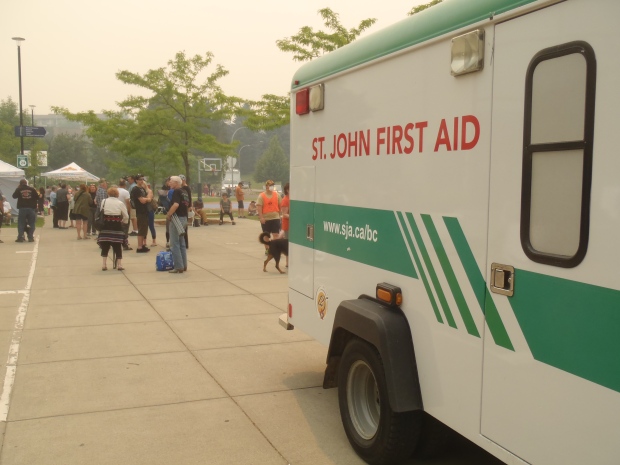CHARBONNEAU – Kamloops’ rating of high wildfire risk is doubtful

Under a hazy sky, evacuees gather at TRU reception centre in this 2017 file photo. (Image: Mel Rothenburger)
WHY WOULD a small Toronto-based insurance broker release arcane data that shows Kamloops to be at highest risk of wildfires — in all of Canada?
BC Wildfire Service fire information officer, Forrest Tower, says the report is unfair:
 “I wouldn’t say it’s probably fair to rank Kamloops as No. 1 if we’re looking across all of B.C. for a large number of factors. They’re using Natural Resource Canada information. That is a good source of information, but how they’re using that information may not be in the interest of actually relaying wildfire risk.”
“I wouldn’t say it’s probably fair to rank Kamloops as No. 1 if we’re looking across all of B.C. for a large number of factors. They’re using Natural Resource Canada information. That is a good source of information, but how they’re using that information may not be in the interest of actually relaying wildfire risk.”
Not only is the ranking is unfair, the use of data from Natural Resource Canada is misleading.
The insurance brokers, called MyChoice Financial, used obscure ratings called the Forecast Severity Rating (FSR) and the Forecast Severity Anomaly (FSA) from May to September 2023.
I would charitably call MyChoice’s rankings an academic exercise.
After all, MyChoice is not an insurance company. They attract customers with claims of finding the lowest rates from insurance companies. According to their website:
“Here at MyChoice we understand what shopping for car and home insurance is like and believe that nobody should have to overpay when it comes to their premiums. Getting insurance that’s right for you can be a bit of an ordeal, but our main mission is to help you see how much of a breeze it can be.”
If they were an insurance company, they would have reason to be concerned. The 2016 wildfire in Fort McMurray led to the highest insurable loss ($4 billion) in Canada’s history.
And why would MyChoice use the incomprehensible ratings, the FSR and the FSA from 2023, when Natural Resources Canada has maps that show wildfire risks for this year?
The maps show that for July, 2024, the Forecast Severity Rating in eastern Canada and the Maritimes is low. For central Canada the rating is moderate. In the west, the forecast is mixed: extreme around Yellowknife and southern B.C., high in-between except for moderate pockets on the north coast and Edmonton area.
For August, the Forecast Severity Rating for eastern and central Canada remains the same as July. In the west, the rating is severe for southern B.C., Alberta, Saskatchewan, and parts of Manitoba.
Natural Resources Canada cautions use of the FSR and FSA:
“Disclaimer: These forecasts are experimental and have yet to be fully validated and calibrated. These forecasts should be viewed not for their accuracy, but for the general trends they present and are to be used as a long-range planning tool by fire resource managers.”
What does reveal wildfire risk is not the tedious exercise performed by the insurance broker but by physical, on-the-ground, factors.
The highest wildfire risk to cities is the proximity of dense forests. When a wildfire starts in a forest, it can quickly spread to nearby cites, especially during dry conditions. Places like Fort McMurray and Kelowna are prime examples.
Kamloops is not surrounded by forests. Unlike other cities we have not had city-wide wildfire evacuations. The likelihood of a wildfire enveloping Kamloops is minimal. Wildfires often surround Kamloops, but except for higher elevations the risk is moderate.
David Charbonneau is a retired TRU electronics instructor who hosts a blog at http://www.eyeviewkamloops.wordpress.com.

Leave a comment